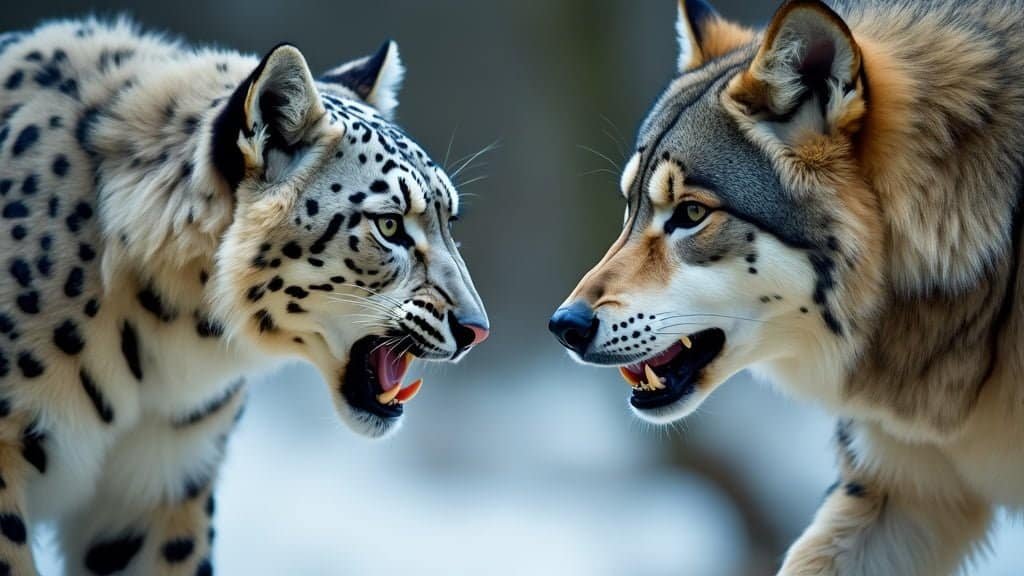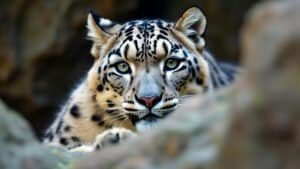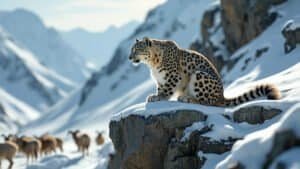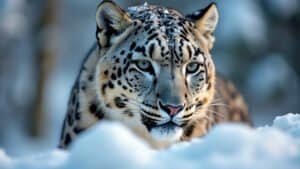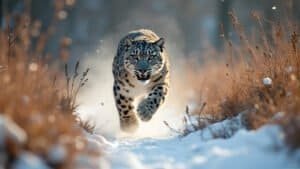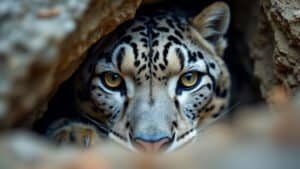Introduction
Snow leopards, elusive and solitary predators of the high-altitude regions of Central and South Asia, face intense competition for food from several other formidable hunters, including brown bears, wolves, lynx, and eagles. Each of these predators has developed its own strategies for survival in the harsh, resource-scarce environments they share
This article explores how snow leopards compete with these animals, examining their hunting techniques, territorial behaviors, and strategies to secure prey. By understanding these dynamics, we can gain deeper insights into the complex relationships that define the ecosystems snow leopards inhabit
How Snow Leopards Compete with Brown Bears for Food
Snow leopards and brown bears, both formidable predators, often share overlapping territories in the rugged mountainous regions of Central and South Asia
Despite their differences in size and hunting strategies, these two species compete for similar prey, leading to a complex relationship defined by both direct and indirect competition
Hunting Techniques and Prey Preferences
Snow leopards are primarily solitary hunters, relying on stealth and agility to ambush prey. They excel at navigating steep, rocky terrain, which allows them to pursue mountain-dwelling species like the Himalayan blue sheep (bharal), ibex, and argali sheep
Their powerful hind legs enable them to leap impressive distances to catch prey, often in challenging, high-altitude environments
In contrast, brown bears, which can weigh up to 1,500 pounds, are opportunistic omnivores with a more diverse diet. While they do hunt larger mammals, they are also known to forage for plants, roots, and berries. In regions where their territories overlap with snow leopards, brown bears often target the same ungulates, such as ibex and argali
However, their hunting style is more straightforward, relying on their immense strength rather than speed or stealth
The competition between these two species often arises when prey is scarce, particularly during the harsh winter months. Snow leopards, with their specialized hunting techniques, tend to target prey in areas that are difficult for the heavier and less agile brown bears to access
However, when food is scarce, brown bears may venture into these difficult terrains, increasing the likelihood of encounters and competition
Territorial Overlaps and Conflicts
The territories of snow leopards and brown bears can overlap significantly, especially in the vast mountain ranges of Central Asia
Snow leopards typically occupy large territories ranging from 50 to over 400 square miles, depending on prey availability. Brown bears, on the other hand, can cover even larger areas, sometimes up to 1,500 square miles, as they roam in search of food
Conflicts between these two species are relatively rare but not unheard of. Snow leopards are generally cautious and avoid direct confrontations with brown bears due to the bears’ size and strength. However, when they do come into contact, snow leopards may abandon a kill if a brown bear approaches, recognizing the danger of a physical confrontation
One notable example of this behavior was documented in Mongolia’s Altai Mountains, where a snow leopard was observed leaving its kill—a freshly hunted ibex—when a brown bear approached
The bear, being much larger, took over the kill with little resistance from the snow leopard. This type of interaction highlights the power dynamics at play when these two predators share the same environment
Seasonal Variation in Competition
The competition between snow leopards and brown bears is heavily influenced by seasonal changes. During the spring and summer, brown bears have access to a wider variety of food sources, including plants and smaller animals, which reduces direct competition with snow leopards
However, in the winter, when plant-based food is scarce, brown bears rely more on large ungulates, which are also the primary prey of snow leopards
Winter is particularly challenging for both species, as deep snow and cold temperatures limit prey availability
Snow leopards, adapted to cold climates with their thick fur and large paws, continue to hunt in higher elevations where brown bears may struggle to access due to their size and reduced mobility in deep snow
Interestingly, the seasonal behavior of brown bears also affects competition. As hibernators, brown bears spend several months in a state of torpor during the winter, reducing direct competition during this period. However, in some regions, not all brown bears hibernate, particularly those in milder climates or with access to abundant food sources
In such cases, the overlap in active hunting periods between the two species increases, leading to more frequent competition for the limited winter prey
Snow Leopards vs. Wolves: Competing Predators in the Mountains
Snow leopards and wolves are both apex predators in the mountainous regions of Central and South Asia, where they often share overlapping territories. Despite their different hunting styles and social structures, these predators compete for similar prey, leading to a delicate balance between coexistence and competition
Habitat and Prey Overlap
Snow leopards and wolves both inhabit the rugged, high-altitude environments of the Himalayas, the Tian Shan, and other mountain ranges
These areas, characterized by steep slopes and rocky outcrops, are home to a variety of ungulates, which form the primary diet for both species. Common prey includes the Himalayan blue sheep (bharal), ibex, and argali sheep
Wolves, which hunt in packs, have a different approach to securing food compared to the solitary snow leopard. The pack structure of wolves allows them to take down larger prey and to do so more frequently, increasing their impact on prey populations in shared habitats
While snow leopards rely on ambush tactics and the element of surprise, wolves use coordinated pack strategies to chase and exhaust their prey before delivering the final blow
This difference in hunting strategies means that snow leopards and wolves may target different individuals within the same prey species
For example, wolves might focus on weaker or slower members of a herd, while snow leopards may target isolated individuals or those in difficult-to-reach areas. Despite these differences, the overlap in prey species leads to direct competition, particularly when prey is scarce
Pack Dynamics vs. Solitary Hunting
The most significant difference between snow leopards and wolves lies in their social structures. Snow leopards are solitary animals, except during mating season or when a mother is raising cubs
This solitary lifestyle means that each snow leopard must independently find, stalk, and kill its prey, which can be a challenging and energy-intensive process
In contrast, wolves live and hunt in packs, with a highly organized social structure that allows them to coordinate their hunting efforts. A wolf pack typically consists of an alpha pair, their offspring, and sometimes other related or unrelated wolves
The pack works together to hunt, bringing down prey that a single wolf could not manage alone
This pack behavior gives wolves a competitive edge in areas where their territories overlap with snow leopards. A pack of wolves can dominate a hunting area, depleting prey populations more quickly and leaving fewer opportunities for solitary hunters like the snow leopard
However, the solitary nature of snow leopards also means they are more adaptable in some ways; they can survive on smaller kills that might not sustain a wolf pack
Impact of Wolf Presence on Snow Leopard Behavior
The presence of wolves in a shared territory has a noticeable impact on snow leopard behavior
Snow leopards tend to avoid direct confrontations with wolves, as a pack of wolves poses a significant threat to a lone snow leopard. Instead, snow leopards may adjust their hunting times to avoid wolves, opting to hunt at dawn or dusk when wolves are less active
There is also evidence that snow leopards alter their movement patterns and territory usage in response to wolf activity. In some studies, snow leopards have been observed avoiding areas where wolves are known to hunt, particularly during the winter when competition for prey is most intense
Interestingly, wolves can sometimes inadvertently benefit snow leopards. In cases where a wolf pack makes a kill but leaves part of it behind, a snow leopard may scavenge from the leftovers. However, this behavior is risky, as returning wolves might challenge the snow leopard for the remains
The competitive dynamic between snow leopards and wolves is a prime example of the complex interactions that shape predator communities in the mountains. Each species has developed strategies to maximize its success while minimizing direct conflict, leading to a delicate balance within their shared ecosystem
Lynx and Snow Leopards: Navigating Shared Territory
Lynx and snow leopards, both solitary predators, often share the mountainous terrains of Central Asia. While these two species do not often directly confront each other, their overlapping territories and similar prey preferences create a subtle but significant competition
Prey Selection and Hunting Methods
Both snow leopards and lynx primarily hunt small to medium-sized ungulates, though their exact prey selection can differ based on their respective sizes and hunting techniques
Snow leopards, being larger, typically go after bigger prey such as the Himalayan blue sheep (bharal), ibex, and argali sheep. Their powerful limbs and stealthy approach allow them to stalk and ambush these larger animals, even in the most challenging terrains
Lynx, on the other hand, are smaller and tend to focus on smaller prey, such as roe deer, hares, and various small mammals and birds. They rely on a combination of stealth and short bursts of speed to capture their prey, often in more forested or shrub-covered areas within their mountainous habitats
However, in regions where prey is scarce, lynx might target the young or smaller members of the same ungulate species hunted by snow leopards, bringing them into direct competition
The overlap in prey species means that, although they target different sizes, both predators can reduce each other’s food availability. This competition is most pronounced during harsh winters when prey is harder to find, and both predators might be forced to hunt in closer proximity
Avoidance Strategies and Conflict Mitigation
Despite their overlapping territories and potential competition, direct confrontations between snow leopards and lynx are rare. Both species have developed strategies to avoid conflicts, relying on the vast and often harsh landscapes they inhabit to minimize encounters
One of the key avoidance strategies is temporal separation. Snow leopards are known to be more active during dawn and dusk, while lynx may vary their activity patterns depending on prey availability and environmental conditions. This difference in peak hunting times reduces the likelihood of encounters between the two species
Spatial separation is another important strategy. Snow leopards prefer the higher, more rugged parts of the mountains, where they can use the steep terrain to their advantage in hunting
Lynx, while also capable climbers, often remain in lower, more vegetated areas that provide better cover for their ambush tactics. This natural division of the landscape helps each predator maximize its hunting success while minimizing direct competition
When encounters do occur, the outcome is generally dictated by the size and strength differences between the two species. Snow leopards, being significantly larger, would likely dominate in any direct conflict
However, lynx are highly elusive and avoid confrontation, quickly retreating if they sense a snow leopard nearby. This instinctual avoidance further reduces the chances of direct competition turning into conflict
Comparative Success in Harsh Conditions
The harsh conditions of the high-altitude habitats shared by lynx and snow leopards play a significant role in shaping their competition and coexistence. Both species are well-adapted to cold climates, with thick fur coats and specialized hunting strategies that allow them to survive in environments where food is scarce and the weather is extreme
Snow leopards, with their larger size and greater strength, are better equipped to take down large prey that can sustain them through the lean winter months. This ability gives them an edge in terms of survival during the harshest periods, but it also means they need to expend more energy on each hunt, making every kill crucial
Lynx, on the other hand, may have a survival advantage in certain conditions due to their smaller size and more versatile diet. They can sustain themselves on a wider variety of smaller prey, which can be more abundant than the large ungulates snow leopards rely on
This flexibility allows lynx to survive in areas where larger prey might be less accessible, particularly during harsh winters or in areas heavily hunted by snow leopards
The competition between lynx and snow leopards is a nuanced and complex relationship, shaped by their shared environment and the need to adapt to the challenges of mountain life. While direct confrontations are rare, the competition for food resources influences their behavior, territory usage, and overall survival strategies
Defending Against Eagles: Snow Leopard Strategies
While snow leopards are formidable predators, they must also contend with a variety of scavengers and smaller predators in their mountainous habitats. Among these, large birds of prey like eagles pose a unique challenge
Although eagles are not direct competitors for the same prey, they often scavenge from snow leopard kills or target snow leopard cubs, leading to a need for defensive strategies
Scavenging Risks and Kill Protection
Eagles, particularly golden eagles, are known for their powerful talons and sharp eyesight, which allow them to spot and target potential food sources from great distances
When snow leopards make a kill, especially in open areas or exposed locations, eagles can quickly swoop down to scavenge. This can be a significant problem for snow leopards, as eagles can eat a substantial portion of a kill before the snow leopard returns or while it is still feeding
To mitigate this risk, snow leopards often drag their kills to secluded or hard-to-reach locations, such as rocky outcrops or dense vegetation, where it is more difficult for eagles and other scavengers to access the carcass. This behavior not only helps the snow leopard protect its food from being stolen but also reduces the chances of drawing unwanted attention from other predators in the area
In addition to dragging kills to hidden locations, snow leopards may cover their prey with snow or debris to further obscure it from the sight of scavengers. This strategy can be particularly effective in snowy environments where the natural camouflage of snow and rocks can make it challenging for eagles to spot the concealed kill
Differences in Prey Focus
Snow leopards and eagles generally have different prey preferences, which reduces direct competition but still creates points of conflict
Snow leopards primarily target medium to large ungulates, while eagles typically hunt smaller mammals, birds, and even reptiles. However, eagles are opportunistic and will not hesitate to take advantage of a snow leopard’s kill if given the chance
In some cases, eagles may focus on the weaker or smaller members of a herd that snow leopards target, such as young or injured animals. This overlap in prey interest can lead to a competitive dynamic where both predators are drawn to the same area or prey
For instance, an eagle might attempt to prey on a young ibex or sheep that a snow leopard has already isolated, leading to a potential clash over the kill
Moreover, while snow leopards generally ignore smaller prey that eagles might target, such as hares or birds, the presence of eagles in the area can still impact snow leopard hunting strategies
If an eagle begins circling above a potential prey area, it could alert the prey animals to the presence of a predator, indirectly affecting the success of the snow leopard’s hunt
Adaptations to Aerial Threats
Beyond scavenging, eagles also pose a threat to snow leopard cubs. Eagle attacks on young animals are well-documented, and snow leopard cubs, especially in their early months, are vulnerable to these aerial predators. This danger requires snow leopard mothers to be particularly vigilant in protecting their offspring
To safeguard their cubs, snow leopard mothers choose den sites that are well-protected and difficult for eagles to access. These sites are often located in caves, under overhangs, or in other sheltered areas that provide cover from above
Additionally, snow leopard mothers may leave their cubs in these safe locations while they hunt, returning periodically to check on and nurse them
Another adaptive behavior is the careful timing of hunts. Snow leopards might prefer to hunt during times when eagles are less active, such as in the early morning or late evening. By hunting during these hours, snow leopards reduce the risk of drawing attention from eagles and other scavengers
Overall, while eagles are not the most significant competitors snow leopards face, they represent a notable challenge in the high-altitude environments both species inhabit
Through a combination of strategic kill protection, choice of den sites, and timing of activities, snow leopards effectively mitigate the risks posed by these powerful birds of prey
Conclusion
Snow leopards, as solitary and elusive predators, face significant competition from a variety of other animals in their harsh mountainous habitats
Whether contending with the immense strength of brown bears, the pack dynamics of wolves, the elusive strategies of lynx, or the aerial prowess of eagles, snow leopards have developed a range of strategies to survive and thrive
By using stealth and agility, choosing strategic hunting and denning sites, and adapting to the presence of other predators, snow leopards navigate the complex web of competition that defines their ecosystem
Understanding these interactions not only sheds light on the resilience of snow leopards but also highlights the delicate balance of predator coexistence in some of the world’s most challenging environments
